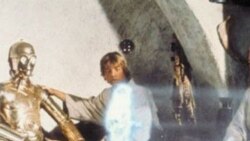Or download MP3 (Right-click or option-click and save link)
This is the VOA Special English Technology Report.
High-quality systems used in video conferencing are called telepresence systems. The images are life-size yet not truly lifelike. They lack the depth that people would normally see if they were in the same room together. But this could change in the future with new kinds of three-dimensional telepresence systems.
Last week, we told you about a 3-D system at the University of Arizona. Researchers can send a moving image over the Internet and show it on a special screen in close to real time. People would not have to wear special glasses like they often need to watch 3-D movies.
The system uses a lot of cameras to take pictures of a person from different positions. Lasers reproduce the pictures combined into three-dimensional images, or holograms. The image appears more realistic with the more cameras that are used and the more pictures that are taken.
Howard Lichtman is president of the Human Productivity Lab. His company advises other companies on buying and using telepresence systems. Mr. Lichtman also publishes Telepresence Options, which reports on the industry.
He says this latest development would have done wonders for the "Star Wars" movie with the famous "Princess Leia" hologram scene.
HOWARD LICHTMAN: "For Princess Leia to talk, Princess Leia needs to move and her mouth needs to move, etc. And you haven't been able to do that with a regular hologram because the hologram would only be fixed in one spot. What they're able to do is, they're able to refresh that image so that the image changes the same way a person changes when they talk."
The researchers in Arizona say their 3-D system is still years away from completion. Even then, Howard Lichtman says it may have trouble competing with systems already on the market.
Most telepresence systems are two-dimensional. But Mr. Lichtman says the images are very realistic.
HOWARD LICHTMAN: "It's a 2-D image, but it's crystal clear, photo realistic, fluid movement, accurate flesh tones, and you would swear you were in the same physical space with people who might be thousands of miles away."
He says prices for telepresence systems are going down as more people use the technology.
HOWARD LICHTMAN: "It's pushing down to everybody as these environments are becoming publicly available or you can rent them by the hour, and at the same time that you're getting very high quality, high definition video conferencing showing up on mobile devices and in the home delivered through the set-top box or through the PC."
A new eighteen-million-dollar project aims to create eleven telepresence centers for federal employees around the United States. The government is working with the AT&T company to save money and reduce pollution by reducing the need for travel.
And that's the VOA Special English Technology Report, written by June Simms. I'm Steve Ember.







